I am trying to fit an exponential decay function with convolution to a measured instrument response using python and lmfit.
I am new to python and I am trying to follow the code in https://groups.google.com/group/lmfit-py/attach/90f51c25ebb39a52/deconvol_exp2.py?part=0.1&authuser=0.
import numpy as np
from lmfit import Model
import matplotlib.pyplot as plt
import requests
# Load data
url = requests.get('https://groups.google.com/group/lmfit-py/attach/73a983d40ad945b1/tcspcdatashifted.csv?part=0.1&authuser=0')
x,decay1,irf=np.loadtxt(url.iter_lines(),delimiter=',',unpack=True,dtype='float')
plt.figure(1)
plt.semilogy(x,decay1,x,irf)
plt.show()
# Define weights
wWeights=1/np.sqrt(decay1+1)
# define the double exponential model
def jumpexpmodel(x,tau1,ampl1,tau2,ampl2,y0,x0,args=(irf)):
ymodel=np.zeros(x.size)
t=x
c=x0
n=len(irf)
irf_s1=np.remainder(np.remainder(t-np.floor(c)-1, n)+n,n)
irf_s11=(1-c+np.floor(c))*irf[irf_s1.astype(int)]
irf_s2=np.remainder(np.remainder(t-np.ceil(c)-1,n)+n,n)
irf_s22=(c-np.floor(c))*irf[irf_s2.astype(int)]
irf_shift=irf_s11+irf_s22
irf_reshaped_norm=irf_shift/sum(irf_shift)
ymodel = ampl1*np.exp(-(x)/tau1)
ymodel+= ampl2*np.exp(-(x)/tau2)
z=Convol(ymodel,irf_reshaped_norm)
z+=y0
return z
# convolution using fft (x and h of equal length)
def Convol(x,h):
X=np.fft.fft(x)
H=np.fft.fft(h)
xch=np.real(np.fft.ifft(X*H))
return xch
# assign the model for fitting
mod=Model(jumpexpmodel)
When defining the initial parameters for the fit, I am getting the error.
ValueError: The truth value of an array with more than one element is ambiguous. Use a.any() or a.all()
#initialize the parameters - showing error
pars = mod.make_params(tau1=10,ampl1=1000,tau2=10,ampl2=1000,y0=0,x0=10,args=irf)
pars['x0'].vary =True
pars['y0'].vary =True
print(pars)
# fit this model with weights, initial parameters
result = mod.fit(decay1,params=pars,weights=wWeights,method='leastsq',x=x)
# print results
print(result.fit_report())
# plot results
plt.figure(5)
plt.subplot(2,1,1)
plt.semilogy(x,decay1,'r-',x,result.best_fit,'b')
plt.subplot(2,1,2)
plt.plot(x,result.residual)
plt.show()
Based on the documentation for lmfit.model, I suspect, this is because of how argument irf is defined in model as args=(irf). I have tried to pass irf to model instead of params. I have also tried to use **kwargs.
What is the correct way to incorporate irf into the model for convolution and fit the data?

